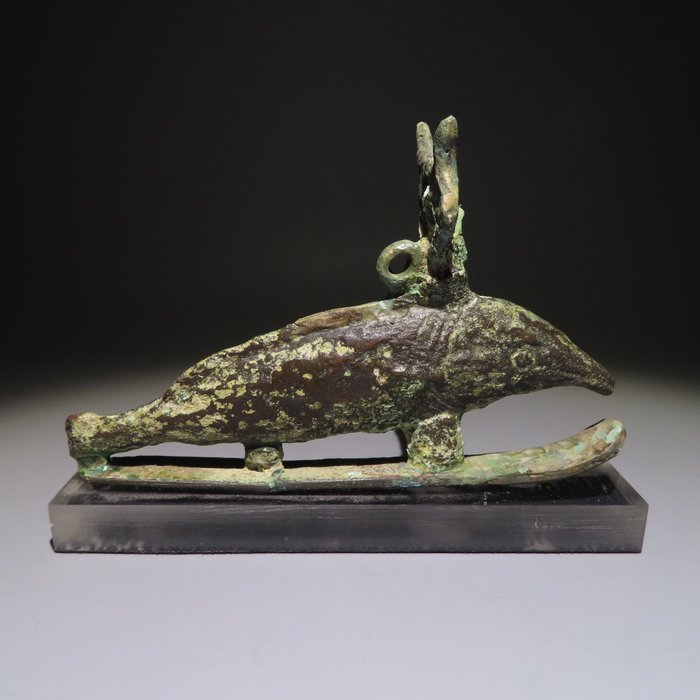編號 89894693

古埃及 青銅色 俄克斯林科斯魚神的雕像。長 11 公分。
編號 89894693

古埃及 青銅色 俄克斯林科斯魚神的雕像。長 11 公分。
EGYPTIAN FIGURE OF OXYRHYNCHOS FISH
Perfect SOLID BRONZE, very good patina!
11 cm Large and 6,8 cm Height (without stand).
EGYPT, LATE PERIOD 664 - 332 BC
Provenance: Private collection, Spain. Private collection, Germany, 1980.
Condition: Very good, top of the crown horns restored.
STAND DISPLAY INCLUDED.
His is one of the most remarkable representations I have ever seen of the Oxyrhynchus fish. The animal is depicted in its typical form, with a distinctive elongated, downturned snout and equally distinctive bifurcated tail. The fish is wearing a headdress with frontal uraeus, surmounted by a solar disc between cow’s horns, the crown of the goddess Hathor, to whom the fish was sacred. The animal has a suspension loop behind and a long, thin dorsal fin which terminates in the tail. Its deeply recessed eyes were possibly once inlaid (cornserve an original inlay in one eye). The fish is perched on a sled with two papyrus columns, attached by means of the lower fins, tail and curved end of the base where it joins the mouth. The whole statuette has a rectangular base with two tangs for attachment.
There are two features that makes this representation so special. First there is a stunningly beautiful detailing of the animal's skin. The scales are very finely incised; it has been suggested that in view of this quality, the body of the fish may have been gilded. Equally well detailed are the collar, the gills and striations on the top and tail fins.
The ancient Upper Egyptian town Per-Medjed (modern el-Bahnasa) was the capital of the 19th Upper Egyptian nome. It was called Oxyrhynchos Polis by the Greeks, which means "Town of the sharp-snouted fish". This refers to a species of fish that lived in the Nile and that, according to mythology, ate the penis / phallus of Osiris after the dismemberment of this god by his brother Seth. It has been debated which species of fish it is, and there is some consensus that it is a species of mormyrus.
According to Greek historian Plutarchos (1st-2nd century C.E.) the inhabitants of Oxyrhynchos and those of a neighbouring town called Kynopolis ("Town of the Dog") were engaged in hostilities because a person from the latter town ate a sacred fish, after which the inhabitants of Oxyrhynchos started catching and eating dogs; this resulted in a civil war which had to be ended by the Romans (De Iside et Osiride, 72).
Literature:
For similar examples with a loop, balanced on a sled or an integral base, see: Arielle P. Kozloff, Animals in Ancient Art from the Leo Mildenberg Collection (Mainz am Rhein, Philipp von Zabern, 1981), fig. 60; Emma Brunner-Traut - Hellmut Brunner - Johanna Zick-Nissen, Osiris, Kreuz und Halbmond. Die Drei Religionen Ägyptens (Mainz am Rhein, Philipp von Zabern, 1984), fig. 16.
Notes:
The seller guarantees that he acquired this piece according to all national and international laws related to the ownership of cultural property. Provenance statement seen by Catawiki.
The seller will take care that any necessary permits, like an export license will be arranged, he will inform the buyer about the status of it if this takes more than a few days.
#ancientcivilisations
